In his 1913 children’s book, The Patchwork Girl of Oz, L. Frank Baum added a bit of music criticism into his text. His characters disapprove of classical music, ragtime, and ‘popular’ music, and, in fact, you sense a slight disapproval of having machine to play music at all.
The Patchwork Girl Is brought to life by Dr. Pipt to become a servant in his house for his wife Margolotta. While sprinkling some of his Powder of Life on the figure, there’s an accident and some of the Powder of Life falls on a phonograph sitting in the corner and brings it to life, too.
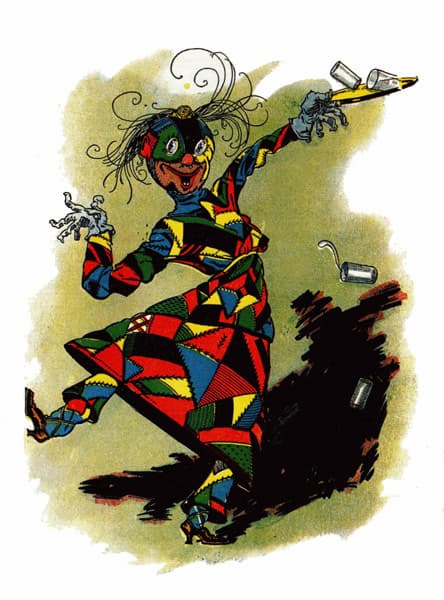
John Neill: The Patchwork Girl (L. Frank Baum: The Patchwork Girl of Oz, 1913)
As soon as breakfast was over they all went into the Magician’s big workshop, where the Glass Cat was lying before the mirror and the Patchwork Girl lay limp and lifeless upon the bench.
“Now, then,” said Dr. Pipt, in a brisk tone, “we shall perform one of the greatest feats of magic possible to man, even in this marvelous Land of Oz. In no other country could it be done at all. I think we ought to have a little music while the Patchwork Girl comes to life. It is pleasant to reflect that the first sounds her golden ears will hear will be delicious music.”
As he spoke he went to a phonograph, which was screwed fast to a small table, and wound up the spring of the instrument and adjusted the big gold horn.
“The music my servant will usually hear,” remarked Margolotte, “will be my orders to do her work. But I see no harm in allowing her to listen to this unseen band while she wakens to her first realization of life. My orders will beat the band, afterward.”
The phonograph was now playing a stirring march tune and the Magician unlocked his cabinet and took out the gold bottle containing the Powder of Life.
They all bent over the bench on which the Patchwork Girl reclined. Unc Nunkie and Margolotte stood behind, near the windows, Ojo at one side and the Magician in front, where he would have freedom to sprinkle the powder. The Glass Cat came near, too, curious to watch the important scene.
“All ready?” asked Dr. Pipt.
“All is ready,” answered his wife.
So the Magician leaned over and shook from the bottle some grains of the wonderful Powder, and they fell directly on the Patchwork Girl’s head and arms.
…
He … found that the gold bottle that contained the precious powder had dropped upon the stand and scattered its life-giving grains over the machine. The phonograph was very much alive, and began dancing a jig with the legs of the table to which it was attached, and this dance so annoyed Dr. Pipt that he kicked the thing into a corner and pushed a bench against it, to hold it quiet.
“You were bad enough before,” said the Magician, resentfully; “but a live phonograph is enough to drive every sane person in the Land of Oz stark crazy.”
“No insults, please,” answered the phonograph in a surly tone. “You did it, my boy; don’t blame me.”
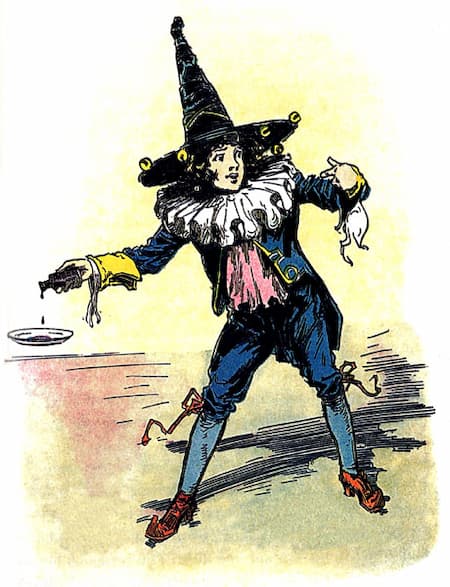
John Neill: Ojo the Unlucky (L. Frank Baum: The Patchwork Girl of Oz, 1913)
Later, three characters, Ojo the Unlucky, Scraps the Patchwork Girl, and the Glass Cat all set out to find a cure for another problem that the Magician has caused: his wife and Ojo’s uncle have been made into statues when the Liquid of Petrifaction fell on them. As with all Oz books, our heroes now have a Quest: to locate and bring back the elements of the magic compound that will restore the statues to life. They are a bit of the way down the road when they are interrupted:
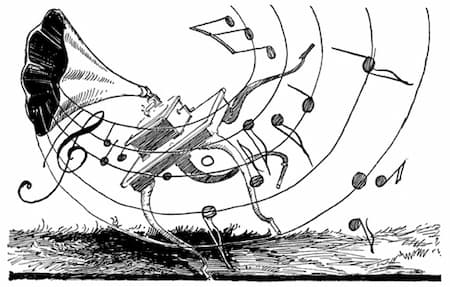
John Neill: The Gramophone (L. Frank Baum: The Patchwork Girl of Oz, 1913)
“Hold on!” shouted the phonograph. “Wait for me!”
“Goodness me; it’s that music thing which the Crooked Magician scattered the Powder of Life over,” said Ojo.
“So it is,” returned Bungle, in a grumpy tone of voice; and then, as the phonograph overtook them, the Glass Cat added sternly: “What are you doing here, anyhow?”
“I’ve run away,” said the music thing. “After you left, old Dr. Pipt and I had a dreadful quarrel and he threatened to smash me to pieces if I didn’t keep quiet. Of course I wouldn’t do that, because a talking-machine is supposed to talk and make a noise—and sometimes music. So I slipped out of the house while the Magician was stirring his four kettles and I’ve been running after you all night. Now that I’ve found such pleasant company, I can talk and play tunes all I want to.”
Ojo was greatly annoyed by this unwelcome addition to their party. At first he did not know what to say to the newcomer, but a little thought decided him not to make friends.
“We are traveling on important business,” he declared, “and you’ll excuse me if I say we can’t be bothered.”
“How very impolite!” exclaimed the phonograph.
“I’m sorry; but it’s true,” said the boy. “You’ll have to go somewhere else.”
“This is very unkind treatment, I must say,” whined the phonograph, in an injured tone. “Everyone seems to hate me, and yet I was intended to amuse people.”
“It isn’t you we hate, especially,” observed the Glass Cat; “it’s your dreadful music. When I lived in the same room with you I was much annoyed by your squeaky horn. It growls and grumbles and clicks and scratches so it spoils the music, and your machinery rumbles so that the racket drowns every tune you attempt.”
“That isn’t my fault; it’s the fault of my records. I must admit that I haven’t a clear record,” answered the machine.
“Just the same, you’ll have to go away,” said Ojo.
“Wait a minute,” cried Scraps. “This music thing interests me. I remember to have heard music when I first came to life, and I would like to hear it again. What is your name, my poor abused phonograph?”
“Victor Columbia Edison,” it answered.
“Well, I shall call you ‘Vic’ for short,” said the Patchwork Girl. “Go ahead and play something.”
“It’ll drive you crazy,” warned the cat.
“I’m crazy now, according to your statement. Loosen up and reel out the music, Vic.”
“The only record I have with me,” explained the phonograph, “is one the Magician attached just before we had our quarrel. It’s a highly classical composition.”
“A what?” inquired Scraps.
“It is classical music, and is considered the best and most puzzling ever manufactured. You’re supposed to like it, whether you do or not, and if you don’t, the proper thing is to look as if you did. Understand?”
“Not in the least,” said Scraps.
“Then, listen!”
At once the machine began to play and in a few minutes Ojo put his hands to his ears to shut out the sounds and the cat snarled and Scraps began to laugh.
“Cut it out, Vic,” she said. “That’s enough.”
But the phonograph continued playing the dreary tune, so Ojo seized the crank, jerked it free and threw it into the road. However, the moment the crank struck the ground it bounded back to the machine again and began winding it up. And still the music played.
“Let’s run!” cried Scraps, and they all started and ran down the path as fast as they could go. But the phonograph was right behind them and could run and play at the same time. It called out, reproachfully:
“What’s the matter? Don’t you love classical music?”
“No, Vic,” said Scraps, halting. “We will passical the classical and preserve what joy we have left. I haven’t any nerves, thank goodness, but your music makes my cotton shrink.”
“Then turn over my record. There’s a rag-time tune on the other side,” said the machine.
“What’s rag-time?”
“The opposite of classical.”
“All right,” said Scraps, and turned over the record.
The phonograph now began to play a jerky jumble of sounds which proved so bewildering that after a moment Scraps stuffed her patchwork apron into the gold horn and cried: “Stop—stop! That’s the other extreme. It’s extremely bad!”
Muffled as it was, the phonograph played on.
“If you don’t shut off that music I’ll smash your record,” threatened Ojo.
The music stopped, at that, and the machine turned its horn90 from one to another and said with great indignation: “What’s the matter now? Is it possible you can’t appreciate rag-time?”
“Scraps ought to, being rags herself,” said the cat; “but I simply can’t stand it; it makes my whiskers curl.”
“It is, indeed, dreadful!” exclaimed Ojo, with a shudder.
“It’s enough to drive a crazy lady mad,” murmured the Patchwork Girl. “I’ll tell you what, Vic,” she added as she smoothed out her apron and put it on again, “for some reason or other you’ve missed your guess. You’re not a concert; you’re a nuisance.”
“Music hath charms to soothe the savage breast,” asserted the phonograph sadly.
“Then we’re not savages. I advise you to go home and beg the Magician’s pardon.”
“Never! He’d smash me.”
“That’s what we shall do, if you stay here,” Ojo declared.
“Run along, Vic, and bother some one else,” advised Scraps. “Find some one who is real wicked, and stay with him till he repents. In that way you can do some good in the world.”
The music thing turned silently away and trotted down a side path, toward a distant Munchkin village.
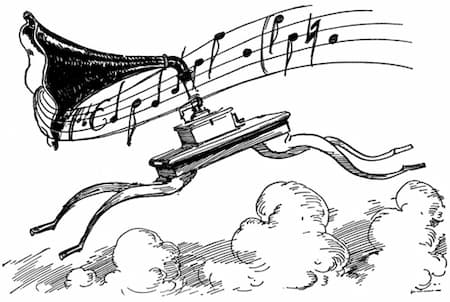
John Neill: The Gramophone runs after them (L. Frank Baum: The Patchwork Girl of Oz, 1913)
Note the instrument’s name (Victor Columbia Edison). The Victor Talking Machine Company started its issue of recordings in 1901; their machine became known as the ‘Victrola’. The Columbia Gramophone company started issuing disc records in 1901, replacing its earlier cylinder recordings. Columbia started issuing double-faced discs in 1908. Edison was the inventor of the phonograph in 1877 and had a long-time business in recordings, first with cylinders then with discs.

Victor V phonograph, ca. 1907
One of the lines in this story seems quite interesting. The phonograph describes what it plays: ‘“It is classical music, and is considered the best and most puzzling ever manufactured. You’re supposed to like it, whether you do or not, and if you don’t, the proper thing is to look as if you did.”’
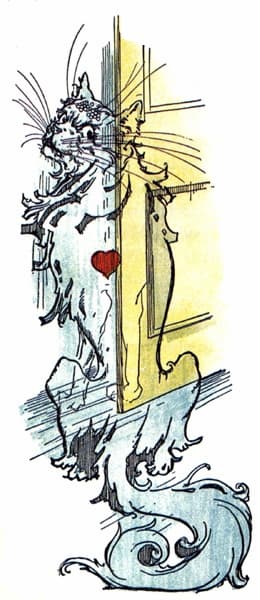
John Neill: The Glass Cat
(L. Frank Baum: The Patchwork Girl of Oz, 1913)
This sounds like the puzzle of anyone who’s been at a classical music concert with experimental music. There are few modern pieces that seem to be understandable at first hearing and when your phonograph insists on dancing to the music as well, things could get very confusing.
Since they didn’t like his piece of classical music, the phonograph asks them to turn the record over to play some ragtime. The early 20th century was a point of peak popularity for ragtime, which hit the popular taste between 1895 and 1919. Since this book came out in 1913, if we look at the ragtime of 1911, we find works such as Irving Berlin’s Alexander’s Ragtime Band and highly forgettable tunes such as When Ragtime Rosie Ragged The Rosary.
Irving Berlin: Alexander’s Ragtime Band (player piano)
After more adventures, the phonograph catches up to them again, looking a little worse for wear:
At this moment a patter of footsteps was heard, and looking up they saw the live phonograph standing before them. It seemed to have passed through many adventures since Ojo and his comrades last saw the machine, for the varnish of its wooden case was all marred and dented and scratched in a way that gave it an aged and disreputable appearance.
“Dear me!” exclaimed Ojo, staring hard. “What has happened to you?”
“Nothing much,” replied the phonograph in a sad and depressed voice. “I’ve had enough things thrown at me, since I left you, to stock a department store and furnish half a dozen bargain-counters.”
“Are you so broken up that you can’t play?” asked Scraps.
“No; I still am able to grind out delicious music. Just now I’ve a record on tap that is really superb,” said the phonograph, growing more cheerful.
“That is too bad,” remarked Ojo. “We’ve no objection to you as a machine, you know; but as a music-maker we hate you.”
“Then why was I ever invented?” demanded the machine, in a tone of indignant protest.
They looked at one another inquiringly, but no one could answer such a puzzling question. Finally the Shaggy Man said:
“I’d like to hear the phonograph play.”
Ojo sighed. “We’ve been very happy since we met you, sir,” he said.
“I know. But a little misery, at times, makes one appreciate happiness more. Tell me, Phony, what is this record like, which you say you have on tap?”
“It’s a popular song, sir. In all civilized lands the common people have gone wild over it.”
“Makes civilized folks wild folks, eh? Then it’s dangerous.”
“Wild with joy, I mean,” explained the phonograph. “Listen. This song will prove a rare treat to you, I know. It made the author rich—for an author. It is called ‘My Lulu.'”
Then the phonograph began to play. A strain of odd, jerky sounds was followed by these words, sung by a man through his nose with great vigor of expression:
“Ah want mah Lulu, mah cross-eyed Lulu;
Ah want mah loo-loo, loo-loo, loo-loo, Lu!
Ah love mah Lulu, mah cross-eyed Lulu,
There ain’t nobody else loves loo-loo, Lu!”
“Here—shut that off!” cried the Shaggy Man, springing to his feet. “What do you mean by such impertinence?”
“It’s the latest popular song,” declared the phonograph, speaking in a sulky tone of voice.
“A popular song?”
“Yes. One that the feeble-minded can remember the words of and those ignorant of music can whistle or sing. That makes a popular song popular, and the time is coming when it will take the place of all other songs.”
“That time won’t come to us, just yet,” said the Shaggy Man, sternly: “I’m something of a singer myself, and I don’t intend to be throttled by any Lulus like your cross-eyed one. I shall take you all apart, Mr. Phony, and scatter your pieces far and wide over the country, as a matter of kindness to the people you might meet if allowed to run around loose. Having performed this painful duty I shall—”
But before he could say more the phonograph turned and dashed up the road as fast as its four table-legs could carry it, and soon it had entirely disappeared from their view.
Here, we have the phonograph’s definition of a popular song: ‘One that the feeble-minded can remember the words of and those ignorant of music can whistle or sing.’ The music example given seems to have been made up by Baum, but reflects music popular from around the same time as ragtime, unfortunately called ‘coon songs,’ which presented a stereotype of black people and black music at the turn of the century. Although they have fortunately vanished from the repertoire, at their height, these songs were everywhere, with over 600 of them published in the 1890s.
One of these songs that’s still in the repertoire, but which has had its associations shifted is Emerson and Howard’s Hello Ma Baby.
Emerson / Howard: Hello, Ma Baby (Joan Morris, mezzo-soprano; William Bolcom, piano)
Now associated with the Warner Brother’s short cartoon One Froggy Evening (1955), this song about talking to your girlfriend on the new-fangled telephone has transmuted into a talking, singing, and high-stepping frog.
Hello my Baby… all frog songs
But all this, perhaps, returns us to the first question: what music could be ‘considered the best and most puzzling ever manufactured’? Looking at music from 1911 and 1912, we have Berg’s Altenberg Lieder.
Alban Berg: 5 Altenberglieder, Op. 4 (arr. A. Schoenberg and D. Wagenaar for voice and chamber ensemble) – No. 1. Seele, wie bist du schöner (Marion Eckstein, mezzo-soprano; Linos Ensemble)
Or Prokofiev’s first and second piano concertos.
Sergei Prokofiev: Piano Concerto No. 1 in D-Flat Major, Op. 10 (Sviatoslav Richter, piano; Prague Symphony Orchestra; Karel Ančerl, cond.)
Or Schoenberg’s Pierrot Lunaire?
Arnold Schoenberg: Pierrot Lunaire, Op. 21 – Part I: No. 1. Moondrunk (Mary Thomas, soprano; London Sinfonietta; David Atherton, cond.)
Any of these might qualify!
To see music and style criticism in a children’s book of 1913 leaves us wondering what’s being left out of children’s books today. The fantasy elements in all of L. Frank Baum’s works: Powder of Life and Liquid of Petrifaction, living stuffed dolls, and walking and talking gramophones still remain beyond what we have in the 20th century.
For more of the best in classical music, sign up to our E-Newsletter



